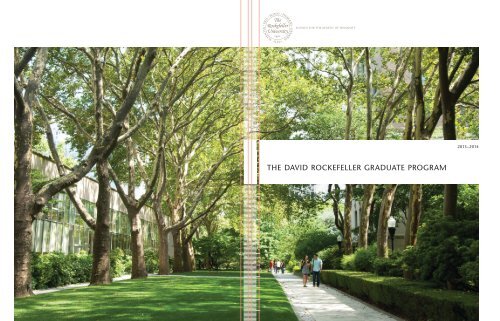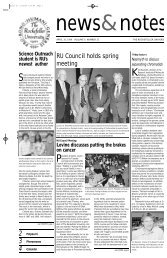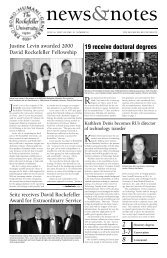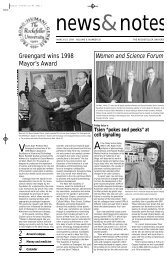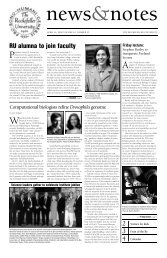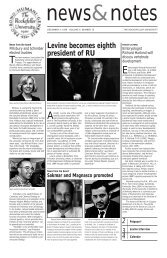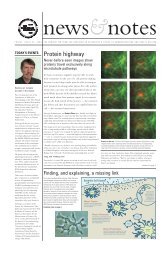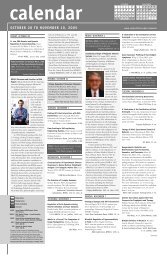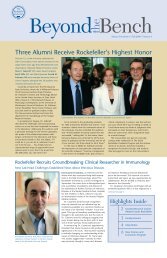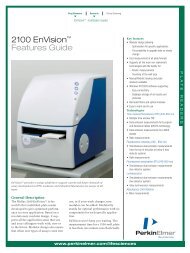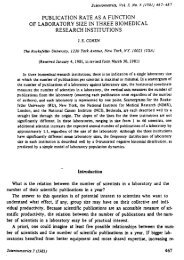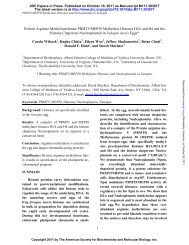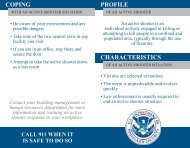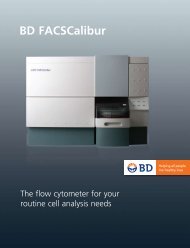Download Brochure - The Rockefeller University
Download Brochure - The Rockefeller University
Download Brochure - The Rockefeller University
Create successful ePaper yourself
Turn your PDF publications into a flip-book with our unique Google optimized e-Paper software.
THE DAVID ROCKEFELLER GRADUATE PROGRAM<br />
2013–2014
At a Glance<br />
THE UNIVERSITY COMMUNITY<br />
• 73 heads of laboratories<br />
• 200 research and clinical scientists<br />
• 350 postdoctoral researchers<br />
• 1,050 clinicians, technicians and staff<br />
• 175 Ph.D. and M.D.-Ph.D. students<br />
• 1,127 alumni<br />
AREAS OF RESEARCH<br />
• Chemical and Structural Biology<br />
• Genetics and Genomics<br />
• Immunology, Virology and Microbiology<br />
• Medical Sciences, Systems Physiology and Human Genetics<br />
• Molecular and Cell Biology<br />
• Neurosciences and Behavior<br />
• Organismal Biology, Evolution, Ethology and Ecology<br />
• Physical, Mathematical and Computational Biology<br />
• Stem Cells, Development, Regeneration and Aging<br />
FACULTY HONORS<br />
• 24 Nobel laureates<br />
• 21 Albert Lasker Awardees<br />
• 20 National Medal of Science recipients<br />
• 33 current members of the National Academy<br />
of Sciences<br />
CLINICAL CONDITIONS UNDER STUDY<br />
• infectious diseases, such as hepatitis, HIV/AIDS and<br />
hospital-acquired MRSA<br />
• neurologic disorders, including Alzheimer’s, Parkinson’s,<br />
epilepsy and ALS<br />
• autoimmune diseases, such as multiple sclerosis, asthma,<br />
lupus and type 1 diabetes<br />
• cancers, including breast, colon and brain tumors<br />
• cardiovascular and metabolic disorders, including heart<br />
disease, stroke, diabetes and obesity<br />
• psychiatric and behavioral disorders, such as schizophrenia,<br />
depression and drug addiction<br />
• genetic disorders, such as cystic fibrosis and inherited<br />
immunodeficiencies<br />
• developmental disabilities, such as autism spectrum<br />
disorders, ADHD and fragile X
PRESIDENT’S MESSAGE 2<br />
DEAN’S MESSAGE 4<br />
1<br />
ACADEMIC PROGRAMS 6<br />
FACULTY AND RESEARCH 12<br />
STUDENT LIFE 20<br />
ADMISSIONS AND SCHEDULE OF COURSES 26
PRESIDENT’S MESSAGE
For me, neuroscience was love<br />
at first sight.<br />
Understanding the brain and wanting to know how to<br />
deconstruct and resolve its complexity fueled my career initially<br />
and still motivates me in my lab today. People fall in<br />
love with science at different times in their lives and for different<br />
reasons, but the common denominator is an excitement<br />
and curiosity to understand the world around them —<br />
that’s what <strong>The</strong> <strong>Rockefeller</strong> <strong>University</strong>’s graduate program is<br />
designed to nurture. It is also what drives <strong>Rockefeller</strong>’s<br />
world-class faculty, who push the boundaries of knowledge<br />
with their innovative approaches to scientific discovery.<br />
In an environment that aims to foster independence and<br />
freedom, both students and faculty chart their own paths.<br />
For faculty, this culture has led to pioneering discoveries<br />
with the potential to eradicate disease and reduce<br />
suffering for millions. For students, it provides flexibility to<br />
work with more than one professor on their chosen thesis<br />
topic. For both, it enables collaboration and interdisciplinary<br />
research, which are the university’s hallmarks.<br />
<strong>Rockefeller</strong> is truly unique, as it exists solely to support<br />
science; thus, every aspect of the administration is dedicated<br />
to the success of our scientists. In fact, every member of our<br />
scientific administration is an active faculty member, with an<br />
active lab. Vital to faculty and student success are modern<br />
and well-equipped buildings, such as the new Collaborative<br />
Research Center. We’re also well served by scientific resource<br />
centers that provide state-of-the-art research support services.<br />
At <strong>Rockefeller</strong>, we believe students should learn science<br />
by doing science, shoulder to shoulder with some of the<br />
world’s leading researchers, who guide and mentor them<br />
every step of the way. As a student at <strong>Rockefeller</strong>, you’ll be<br />
part of a diverse and supportive community that is a haven<br />
for creative, independent thinkers. Your time will be spent<br />
on an extraordinary campus, a green oasis nestled in one of<br />
the most exciting cities in the world.<br />
Deciding where to pursue your graduate training is not<br />
easy, as there are many outstanding institutions from which<br />
to choose. However, <strong>Rockefeller</strong> stands out among its peers,<br />
providing developing scientists an unparalleled educational<br />
experience. We hope you’ll join us.<br />
3<br />
Marc Tessier-Lavigne, President
DEAN’S MESSAGE
<strong>Rockefeller</strong> has a graduate program<br />
unlike any in the world.<br />
Since its beginning more than 50 years ago, five principles<br />
have guided the program:<br />
Recruit the best students, regardless of citizenship.<br />
International diversity is both intellectually and culturally<br />
stimulating. Our current student population consists of<br />
approximately 175 students from 33 countries, a range<br />
made possible by significant private support.<br />
Provide a flexible academic program. Students have diverse<br />
interests and needs. We support individual development by<br />
giving students the freedom to design their own curricula.<br />
<strong>The</strong>y fulfill credit requirements with courses of interest and<br />
may conduct rotations or immediately affiliate with a lab.<br />
Provide generous professional and personal support.<br />
Relieving worries about practical matters allows our students<br />
more time to be creative scientifically. <strong>The</strong>y receive a stipend,<br />
health, dental and vision insurance, subsidized housing and<br />
an annual research allowance for travel and lab support.<br />
Strongly encourage interactions. Students are often the<br />
catalyst for collaborations between labs, and some of the<br />
most revolutionary ideas span disciplines. To foster interactions,<br />
we have an annual student retreat organized and run<br />
by students, as well as numerous lecture series featuring<br />
speakers from around the world.<br />
Ensure careful mentoring. <strong>The</strong> freedom of our graduate<br />
program requires supportive advice and mentoring. Counsel<br />
is provided by the Dean’s Office and, in later years, by a<br />
research adviser and faculty committee.<br />
<strong>The</strong> program has been an extraordinary success. Of<br />
more than 1,100 graduates, two have won the Nobel Prize,<br />
28 are members of the United States National Academy of<br />
Sciences and our alumni occupy influential positions in<br />
academia, industry and many other fields.<br />
Graduate school is an important step in becoming a professional<br />
scientist. Although it has a well-defined end point, it<br />
really is just a beginning. All of the things that go into becoming<br />
a scientist — learning new ideas, perfecting new experimental<br />
techniques, refining analytical abilities — are lifelong<br />
endeavors. Our goal at <strong>Rockefeller</strong> is to equip you with both<br />
the skills and the self-confidence to begin your journey.<br />
5<br />
Sidney Strickland, Dean
ACADEMIC PROGRAMS
“At <strong>Rockefeller</strong>, curiosity is celebrated<br />
in a way that is virtually unequaled<br />
in the academic universe. Our faculty<br />
ask questions that are pushing the<br />
very boundaries of human knowledge.<br />
Our students are at the center of this<br />
research enterprise.”<br />
Paul Nurse, President Emeritus<br />
7<br />
For over 100 years, biomedical science has been <strong>The</strong><br />
<strong>Rockefeller</strong> <strong>University</strong>’s singular priority. Founded in 1901<br />
by John D. <strong>Rockefeller</strong> as <strong>The</strong> <strong>Rockefeller</strong> Institute for<br />
Medical Research, it was the first institution in the United<br />
States devoted solely to understanding the causes of disease.<br />
Today, renamed <strong>The</strong> <strong>Rockefeller</strong> <strong>University</strong>, it is one of the<br />
foremost research centers in the world, with a world-class<br />
faculty including five Nobel Prize laureates and 33 members<br />
or foreign associates of the National Academy of Sciences.<br />
<strong>The</strong> graduate program admitted its first students in<br />
1955, and since then over 1,100 scientists have received<br />
degrees from <strong>Rockefeller</strong>. As a <strong>Rockefeller</strong> graduate student,<br />
you will be part of a diverse community of over 2,000,<br />
including students, postdocs, faculty and administrative staff.<br />
Our location adjacent to Weill Cornell Medical College,<br />
NewYork-Presbyterian Hospital and Memorial Sloan-<br />
Kettering Cancer Center puts us at an epicenter of scientific<br />
activity. Our students truly have the best of both worlds: a
Student Profile<br />
personal, highly flexible training program and access to a<br />
broad range of collaborators and resources.<br />
Ph.D. Program<br />
8<br />
TAMARA OUSPENSKAIA<br />
Fourth-year student<br />
Growing up, Tamara Ouspenskaia always loved math<br />
and thought she might someday use her facility with<br />
numbers in business. After immigrating to Canada from<br />
Russia at the age of 15, however, she was inspired by<br />
a high school science teacher. “Once I learned what<br />
science was really about, I knew that’s what I wanted to<br />
do,” she says.<br />
As an undergraduate at McGill <strong>University</strong>, Tamara<br />
dove into biochemistry. She did stints in physiology<br />
and pharmacology labs, and, for her master’s degree,<br />
she worked to identify novel players in the signaling<br />
cascade for a growth factor, TGF-β. But after her lab<br />
rotations at <strong>Rockefeller</strong>, she decided she wanted<br />
to work in an animal model. She joined Elaine<br />
Fuchs’s Laboratory of Mammalian Cell Biology and<br />
Development to work on stem cells in mice. “It always<br />
bothered me that I couldn’t be sure whether the<br />
work I was doing in cell cultures would actually apply<br />
in real life, so the mouse model was perfect.” Tamara<br />
investigates the function of new genes involved in skin<br />
cancers and was recently awarded a prestigious HHMI<br />
International Student Research Fellowship to support her<br />
work. In Dr. Fuchs, she found a strong female mentor.<br />
“I hope some of her brilliance will rub off on me.”<br />
<strong>Rockefeller</strong>’s Ph.D. program is based on the concept of<br />
learning science by doing science, and our laboratories are at<br />
the center of the Ph.D. training program. <strong>The</strong>re are 73<br />
laboratories at <strong>Rockefeller</strong>, each headed by a tenured or<br />
tenure-track member of the faculty, that study a wide range<br />
of biomedical and related sciences, including biochemistry,<br />
genomics, immunology, microbiology, physiology, molecular<br />
and cell biology, neuroscience, evolution and ecology,<br />
developmental biology and biophysics.<br />
Students who arrive with a particular mentor or project<br />
in mind may immediately join a laboratory; those who<br />
prefer to explore may rotate through several laboratories to<br />
gain exposure to different areas of research. Students choose<br />
a laboratory by the end of their first year and present a<br />
thesis proposal before the end of their second year.<br />
<strong>The</strong> collegial nature of the laboratory environment links<br />
younger students to previous generations from the same lab<br />
as well as to postdocs and faculty mentors. <strong>The</strong> collaborations<br />
that result from these relationships are not only the<br />
basis on which our scientific education is built, they are the<br />
engine that drives the discovery process. Many collaborations<br />
produce exceptional results that lead to publication in<br />
prominent journals. And the relationships formed within<br />
laboratories often lead to lifelong associations.<br />
While formal coursework is minimal, several classes each<br />
semester offer foundations in particular specialties, and three<br />
required courses taken during the first year serve to develop<br />
students’ abilities to critically interpret scientific data, to<br />
promote awareness of research ethics and to introduce<br />
students to research going on in the university’s labs. Beyond<br />
the scheduled curriculum, additional seminars and tutorials<br />
are available based on demand.<br />
As graduate students near the end of their investigations,<br />
they defend their thesis before a panel of faculty members<br />
and present their work to the full <strong>Rockefeller</strong> <strong>University</strong><br />
community.
M.D.-Ph.D. Program<br />
<strong>The</strong> mission of the Tri-Institutional M.D.-Ph.D. Program is<br />
to educate and train physician-scientists, who are able to<br />
bridge the gap between laboratory research and clinical<br />
medicine and thereby contribute toward improving health<br />
and enhancing the quality of life by reducing disability and<br />
death from disease. <strong>Rockefeller</strong> participates in the program<br />
jointly with its two neighbors: Weill Cornell Medical College<br />
and the Graduate School of Medical Sciences of Cornell<br />
<strong>University</strong>, and the Sloan-Kettering Institute at Memorial<br />
Sloan-Kettering Cancer Center.<br />
Approximately 15 students enroll in this highly competitive<br />
program every year, and at any one time 25 or so are<br />
performing thesis research in <strong>Rockefeller</strong> <strong>University</strong> laboratories.<br />
Students spend their first two years in medical school,<br />
while also completing three research rotations. Following<br />
the completion of graduate studies and thesis research at<br />
either <strong>The</strong> <strong>Rockefeller</strong> <strong>University</strong>, the Gerstner Sloan-<br />
Kettering Graduate School of Biomedical Sciences or Weill<br />
Cornell Graduate School of Medical Sciences, students<br />
receive their Ph.D. degrees and then reenter medical school<br />
to complete clinical rotations and receive their M.D. degrees.<br />
With more than 25 years of continuous funding through<br />
the Medical Scientist Training Program of the National<br />
Institutes of Health and significant institutional and foundation<br />
support, the Tri-Institutional M.D.-Ph.D. Program offers<br />
full tuition and stipends. Graduates typically go on to<br />
pursue clinical and advanced research training, and many<br />
alumni of the program occupy research, clinical and administrative<br />
positions at the nation’s top medical schools and<br />
academic medical centers.<br />
Tri-Institutional Training Program<br />
in Chemical Biology<br />
<strong>The</strong> development of new generations of targeted probes<br />
and therapeutics is critically dependent on scientists trained<br />
in the new field of chemical biology. <strong>The</strong> <strong>Rockefeller</strong><br />
<strong>University</strong>, with Weill Cornell Medical College and<br />
Memorial Sloan-Kettering Cancer Center, trains graduate<br />
students to use chemical approaches and technologies to<br />
answer fundamental biological questions. Students, who<br />
receive graduate-level training in both chemistry and<br />
biology, are recruited from top undergraduate chemistry<br />
programs worldwide.<br />
Alumnus Profile<br />
ANDREW PLUMP<br />
Deputy Head of Research and Translational Medicine,<br />
Sanofi<br />
Ask Andrew Plump what he does for a living and you’ll<br />
have a lively discussion. A 1993 <strong>Rockefeller</strong> graduate,<br />
Andy works at the pharmaceutical company Sanofi as<br />
the deputy head of research and translational medicine,<br />
responsible for the global cross-therapeutic research<br />
portfolio. Prior to joining Sanofi in the summer of 2012,<br />
Andy spent 11 years at Merck as the cardiovascular franchise<br />
integrator and subsequently as the cardiovascular<br />
worldwide discovery head. “In both my Sanofi and<br />
Merck roles, I bring together the bench and clinical arms<br />
of pharmaceutical research and development. I coordinate<br />
the work of people across the world into a cohesive<br />
effort to forward the goals of drug development.”<br />
Andy began his education at MIT, where he studied<br />
virology, political science and urban studies. UCSF<br />
Medical School was his next move. “MIT was a very<br />
experiment-driven place, but in medical school the<br />
learning is very memory based and lecture heavy. It<br />
wasn’t long before I wanted to get back in the lab.”<br />
He enrolled in a summer study program with Jan L.<br />
Breslow, head of <strong>Rockefeller</strong>’s Laboratory of Biochemical<br />
Genetics and Metabolism, and later took a leave of<br />
absence from UCSF to enroll in <strong>Rockefeller</strong>’s Ph.D.<br />
program. “Being at <strong>Rockefeller</strong> full time was a wonderful<br />
immersion. <strong>The</strong> environment made it easy to focus<br />
on my work, and my years there were undoubtedly the<br />
most exciting of my professional life.”<br />
9
Student Profile<br />
DEANNA BELSKY<br />
Third-year student<br />
10<br />
After Deanna Belsky did a year of rotations through<br />
several different labs at <strong>Rockefeller</strong> — studying<br />
immunology, developmental biology and neuroscience<br />
— she uncovered a research idea she was eager to<br />
explore: plasticity in the sensory processing region of<br />
the brain. <strong>The</strong>re was just one problem: none of the labs<br />
at <strong>Rockefeller</strong> were studying that specific topic.<br />
“<strong>Rockefeller</strong> is known for encouraging its students<br />
to pursue novel ideas. A colleague suggested a<br />
collaboration between two labs, and I was happy to<br />
find I had a lot of support to do that,” says Deanna,<br />
who did her undergraduate work at Indiana <strong>University</strong><br />
of Pennsylvania. She now divides her time between<br />
President Marc Tessier-Lavigne’s lab, where she draws<br />
on his molecular neuroscience expertise, and Charles<br />
Gilbert’s lab, which helps her examine the brain from a<br />
sensory systems standpoint.<br />
Deanna has another interest she wants to pursue<br />
while at <strong>Rockefeller</strong> — teaching. “<strong>Rockefeller</strong> doesn’t<br />
require its graduate students to teach like other schools<br />
do, but there are opportunities to design courses and<br />
implement them at nearby undergraduate institutions.<br />
I think that’s even better.”<br />
Although she’s still in the preliminary phase of<br />
her project, Deanna’s ambition has already<br />
yielded a National Science Foundation Graduate<br />
Research Fellowship, which provides three years<br />
of research support.
Student Achievements<br />
Like the faculty they train with, <strong>Rockefeller</strong>’s students<br />
are some of the brightest and most accomplished in the<br />
world, and they have been recognized with prestigious<br />
national awards and honors. Nine students have received<br />
the Harold M. Weintraub Graduate Student Award, which<br />
recognizes outstanding achievement in the biological<br />
sciences, since the award’s creation in 2000. <strong>Rockefeller</strong><br />
students also have a long-standing record of obtaining<br />
competitive fellowships from the National Institutes of<br />
Health and the National Science Foundation, among<br />
others, to fund their graduate training.<br />
Career Opportunities<br />
A scientific education at <strong>Rockefeller</strong> can be the first step<br />
in a stellar career in academic research, or it can serve as<br />
the basis for work in other areas. While the majority of<br />
<strong>Rockefeller</strong>’s graduates go on to careers in research or<br />
teaching, others are drawn to the pharmaceutical and<br />
technology industries, businesses or nonprofit organizations.<br />
<strong>The</strong> university works to expose its students to the career<br />
opportunities available to them after graduation and to<br />
help them transition to postdoctoral fellowships or other<br />
positions. A seminar series brings experts in various<br />
fields to campus to discuss their work and their career paths.<br />
Regular science career symposia also connect students with<br />
leaders in fields including academia, industry, public policy<br />
and media and provide workshops on résumé writing and<br />
job interviews.<br />
11
FACULTY AND RESEARCH
“For more than a century, <strong>The</strong> <strong>Rockefeller</strong><br />
<strong>University</strong> has fulfilled the mission my<br />
grandfather had envisioned, to produce<br />
discoveries that would benefit humankind.<br />
It has become one of the world’s great<br />
medical research institutions.”<br />
David <strong>Rockefeller</strong>, Life Trustee<br />
13<br />
<strong>The</strong> university’s faculty tackle scores of different biological<br />
problems, but they all have one thing in common: they’re<br />
here for the science. Whether studying individual cells, model<br />
organisms, human beings or entire populations, <strong>Rockefeller</strong>’s<br />
scientists are working to explore the inner workings of life<br />
and are attempting to unravel the causes of disease. <strong>The</strong><br />
questions they ask and the experiments they perform,<br />
although they vary, are all in service of expanding knowledge,<br />
and the results they generate have opened up new fields<br />
and overturned long-held dogma. It’s this emphasis on inquiry<br />
and discovery above all else that sets <strong>Rockefeller</strong> apart<br />
from its peers and that has sustained its excellence over more<br />
than 100 years. At <strong>Rockefeller</strong>, the formula for success is to<br />
hire only the best scientists and to give them the resources<br />
and freedom they need to do their best work. <strong>The</strong> result is a<br />
faculty that’s passionate, curious, energetic and more than a<br />
little brilliant — and a culture that supports high-risk projects<br />
and rewards intellectual curiosity.
14<br />
Faculty Mentors<br />
At <strong>Rockefeller</strong>, students have over 70 laboratories to choose<br />
from and are free to explore their interests before settling on<br />
one. Regardless of which lab they choose, students will be<br />
sharing the bench with the world’s preeminent scientists,<br />
participating in the innovative research that has earned<br />
<strong>Rockefeller</strong>’s faculty its prestigious reputation.<br />
<strong>Rockefeller</strong> faculty members have relatively little to<br />
distract them from their work. <strong>The</strong> university’s small size<br />
and lack of departmental structure mean that faculty have<br />
fewer administrative duties. As a result, they are able to<br />
spend most of their time running their labs and serving as<br />
collaborators and mentors.<br />
Taken as a whole, the faculty has a record of achievement<br />
that is virtually unmatched in academia. Faculty<br />
throughout the university’s history have been recognized<br />
with 20 National Medal of Science awards, 17 Canada<br />
Gairdner International Awards, 21 Albert Lasker Medical<br />
Research Awards and an impressive 24 Nobel Prizes, five<br />
recipients of which are currently on the faculty. Nearly half<br />
the current faculty are members of the prestigious National<br />
Academy of Sciences, and 16 have been elected to the<br />
Institute of Medicine. <strong>Rockefeller</strong>’s junior faculty members<br />
also have a remarkable record of obtaining competitive<br />
grants and receiving coveted fellowships that recognize<br />
promise and leadership in research.<br />
Award-winning discoveries include the discovery of<br />
the hormone leptin, which is critical to the body’s ability to<br />
regulate its weight; uncovering how stem cells in the skin<br />
undergo a cycle of self-renewal; elucidating how ion channel<br />
proteins help generate nerve impulses; and the discovery<br />
of peptide signals that govern the transport of proteins<br />
inside cells.<br />
New <strong>Rockefeller</strong> faculty members are principally recruited<br />
via an open search mechanism that seeks to identify the most<br />
talented scientists regardless of their field. A large cross section<br />
of the university’s faculty participates in the search process,<br />
and faculty candidate seminars are open to the entire campus.<br />
Two searches are run each year, in the spring and fall.
<strong>Rockefeller</strong> faculty regard students as colleagues and<br />
work to create an open environment where ideas and independence<br />
are encouraged.<br />
Alumna Profile<br />
Research Areas<br />
When <strong>Rockefeller</strong> was founded more than a century ago, its<br />
researchers sought to cure infectious disease. Today, it is<br />
dedicated to unlocking the mysteries of basic science that<br />
will advance modern medicine and lead to new<br />
breakthrough cures.<br />
Centered around 73 cutting-edge laboratories working in<br />
a broad range of fields, <strong>The</strong> <strong>Rockefeller</strong> <strong>University</strong> fosters a<br />
collaborative research environment for its faculty and<br />
provides an innovative educational experience for its select<br />
group of outstanding graduate students and postdoctoral<br />
researchers. To help reduce artificial barriers and provide its<br />
investigators with the greatest degree of freedom,<br />
<strong>Rockefeller</strong> does not have academic departments. As a result,<br />
the university is not constrained to perform research in any<br />
particular field and can recruit the most accomplished and<br />
gifted investigators across a wide spectrum of disciplines in<br />
the sciences. Organizationally, the university’s laboratories<br />
are loosely clustered into nine distinct research areas; these<br />
research areas, some of which were pioneered at <strong>Rockefeller</strong>,<br />
represent the broad fields of study that are being pursued<br />
most actively by the university’s scientists.<br />
CHEMICAL AND STRUCTURAL BIOLOGY<br />
Chemical and structural biologists at <strong>Rockefeller</strong> work to<br />
identify and characterize molecules and molecular assemblies<br />
involved in key biological processes. <strong>The</strong>y employ a full<br />
range of modern tools, including x-ray crystallography,<br />
magnetic resonance spectroscopy, electron microscopy, mass<br />
spectrometry, bioinformatics, computer modeling and<br />
simulation and chemical synthesis, as well as the techniques<br />
of molecular biology and genetics. Driven by advances in<br />
genetic sequencing, their work to relate one-dimensional<br />
DNA sequences to the three-dimensional protein<br />
architectures they encode represents significant progress in<br />
the quest to understand the complex chemical and physical<br />
transformations that underlie living systems.<br />
GENETICS AND GENOMICS<br />
<strong>The</strong> university is home to researchers studying the genetic<br />
basis of human disease, as well as genetic studies of<br />
fundamental biological processes that are still poorly<br />
MANDË HOLFORD<br />
Assistant Professor of Chemical Biology, Hunter College<br />
and the American Museum of Natural History<br />
For a scientist who studies snails, Mandë Holford’s life is<br />
as fast paced as they come. Since graduating from Tom<br />
W. Muir’s lab at <strong>Rockefeller</strong> in 2003, she’s had a National<br />
Science Foundation diplomacy fellowship and a postdoc<br />
in evolutionary biology and electrophysiology, both of<br />
which took her around the world.<br />
When the Brooklyn native was looking at graduate<br />
schools, she was determined to leave New York, but a<br />
visit to <strong>Rockefeller</strong>’s campus changed her mind. “I was<br />
blown away. At <strong>Rockefeller</strong>, the students were happy,<br />
not stressed. From day one, you’re treated like someone<br />
who’s here to learn science,” says Mandë, who studied<br />
expressed protein ligation, a tool that uses organic<br />
chemistry to address biological questions.<br />
Mandë’s career has come full circle: back in New<br />
York, her research at Hunter College and the American<br />
Museum of Natural History explores the structural<br />
function of peptidic toxins in marine snails and their<br />
application to therapeutics. Collecting samples takes<br />
her to Panama and Mozambique, but Mandë is never<br />
far from her <strong>Rockefeller</strong> roots. <strong>The</strong> peptide-synthesizing<br />
machine she uses, and the field of peptide chemistry<br />
itself, were invented by Nobel Prize winner Bruce<br />
Merrifield, whose <strong>Rockefeller</strong> lab was once one floor<br />
above Mandë’s. “At <strong>Rockefeller</strong>, science is the star.<br />
You’re there working with the greats, solving real-world<br />
problems. That was very special to me.”<br />
15
ultimate goal of biomedical research. <strong>Rockefeller</strong>’s scientists<br />
and clinicians study conditions such as cancer, heart<br />
disease, infectious disease, obesity, addiction, psoriasis,<br />
hepatitis C, HIV, mental illness, autoimmune disorders and<br />
many others. <strong>The</strong> <strong>Rockefeller</strong> <strong>University</strong> Hospital serves as<br />
a setting for conducting clinical studies in a carefully<br />
controlled environment.<br />
MOLECULAR AND CELL BIOLOGY<br />
Modern cell biology was founded at <strong>Rockefeller</strong> more than<br />
a half century ago with the introduction of the electron<br />
microscope. <strong>The</strong> field has since evolved into a molecular<br />
phase, which focuses on how cellular and extracellular<br />
macromolecules interact and communicate with each other<br />
to give rise to specific functions and responses. Along with<br />
microscopic and biochemical approaches, <strong>Rockefeller</strong><br />
scientists use a full range of techniques from structural<br />
biology, biophysics, physiology and genetics to study<br />
processes such as gene regulation, protein translation and<br />
modification, intracellular transport, cell cycle and<br />
chromosome biology, organelle function, signal transduction<br />
and enzymology, and cancer.<br />
16<br />
understood. Bioinformatics and emerging technologies<br />
provide sufficient scale to study the human genome, and<br />
New York City’s diverse population gives <strong>Rockefeller</strong><br />
scientists access to research subjects so they can work to<br />
identify human disease genes for complex disorders.<br />
IMMUNOLOGY, VIROLOGY AND MICROBIOLOGY<br />
<strong>The</strong> immune system lies at the heart of many critical areas<br />
of biomedicine, among them stem cell biology, gene therapy,<br />
cancer biology, vascular biology, antiviral immunity and<br />
autoimmune disease. <strong>Rockefeller</strong> laboratories apply the tools<br />
of modern molecular genetics and cell biology to the study<br />
of several critical aspects of the immune system, including<br />
antigen presentation, immunodeficiency syndromes and the<br />
DNA rearrangements that accompany the maturation of<br />
immune cell lineages. <strong>Rockefeller</strong> scientists also study<br />
microbial physiology and pathogenesis, parasitology, tumor<br />
immunology and vaccine development.<br />
MEDICAL SCIENCES, SYSTEMS PHYSIOLOGY<br />
AND HUMAN GENETICS<br />
Translating novel scientific insights into new approaches for<br />
the prevention, diagnosis and treatment of disease is the<br />
NEUROSCIENCES AND BEHAVIOR<br />
<strong>Rockefeller</strong> scientists study the nervous system from many<br />
perspectives, from the isolation of molecules and cells<br />
mediating neural function and development, to the study of<br />
the cellular ensembles engaged in high-level sensory<br />
processing, to the discovery of mechanistic links between the<br />
biology of the brain and particular behavioral states. Topics<br />
of investigation include, among many others: the control of<br />
gene expression in neurons; the formation and patterning of<br />
the embryonic vertebrate nervous system; circadian rhythms;<br />
olfaction; the effects of experience and hormones on brain<br />
plasticity; and the cortical mechanisms of visual perception.<br />
ORGANISMAL BIOLOGY, EVOLUTION,<br />
ETHOLOGY AND ECOLOGY<br />
Several labs focus on studies of the biology of vertebrate and<br />
invertebrate organisms and plants, as well as on the<br />
evolution of species over time. Looking at genetic and<br />
molecular biology from the perspective of entire organisms,<br />
societies and ecosystems reveals how complex traits and<br />
behaviors develop and how disorders of individuals may<br />
affect populations in unexpected ways. Several scientists<br />
working in these areas conduct field research throughout the<br />
world in order to understand the impact of animal or<br />
societal behavior in natural environments.
FACULTY BY AREA OF RESEARCH<br />
CHEMICAL AND<br />
STRUCTURAL BIOLOGY<br />
C. David Allis<br />
Sean F. Brady<br />
Brian T. Chait<br />
Seth A. Darst<br />
David C. Gadsby<br />
Howard C. Hang<br />
Tarun Kapoor<br />
Sebastian Klinge<br />
Roderick MacKinnon<br />
Michael O’Donnell<br />
Charles M. Rice<br />
Michael P. Rout<br />
Thomas P. Sakmar<br />
C. Erec Stebbins<br />
Thomas Tuschl<br />
GENETICS AND<br />
GENOMICS<br />
C. David Allis<br />
Cori Bargmann<br />
Sean F. Brady<br />
Jean-Laurent Casanova<br />
Jeffrey M. Friedman<br />
Mary Jeanne Kreek<br />
Daniel Kronauer<br />
Gaby Maimon<br />
F. Nina Papavasiliou<br />
Charles M. Rice<br />
Robert G. Roeder<br />
Shai Shaham<br />
Agata Smogorzewska<br />
Sidney Strickland<br />
Sohail Tavazoie<br />
IMMUNOLOGY,<br />
VIROLOGY AND<br />
MICROBIOLOGY<br />
Paul Bieniasz<br />
Sean F. Brady<br />
Jean-Laurent Casanova<br />
Brian T. Chait<br />
Vincent A. Fischetti<br />
Howard C. Hang<br />
David D. Ho<br />
James G. Krueger<br />
Luciano Marraffini<br />
Daniel Mucida<br />
Michel C. Nussenzweig<br />
F. Nina Papavasiliou<br />
Jeffrey V. Ravetch<br />
Charles M. Rice<br />
Sanford M. Simon<br />
C. Erec Stebbins<br />
Alexander Tarakhovsky<br />
Alexander Tomasz<br />
MEDICAL SCIENCES,<br />
SYSTEMS PHYSIOLOGY<br />
AND HUMAN GENETICS<br />
Paul Bieniasz<br />
Jan L. Breslow<br />
Jean-Laurent Casanova<br />
Barry S. Coller<br />
Robert B. Darnell<br />
Jeffrey M. Friedman<br />
Mary Jeanne Kreek<br />
James G. Krueger<br />
Charles M. Rice<br />
Sanford M. Simon<br />
Agata Smogorzewska<br />
Sohail Tavazoie<br />
MOLECULAR AND<br />
CELL BIOLOGY<br />
C. David Allis<br />
Paul Bieniasz<br />
Günter Blobel<br />
Ali H. Brivanlou<br />
Brian T. Chait<br />
Nam-Hai Chua<br />
Frederick R. Cross<br />
Robert B. Darnell<br />
Titia de Lange<br />
Hironori Funabiki<br />
Paul Greengard<br />
Howard C. Hang<br />
Mary E. Hatten<br />
Nathaniel Heintz<br />
Tarun Kapoor<br />
M. Magda Konarska<br />
Gaby Maimon<br />
Luciano Marraffini<br />
Paul Nurse<br />
Michael O’Donnell<br />
F. Nina Papavasiliou<br />
Charles M. Rice<br />
Robert G. Roeder<br />
Michael P. Rout<br />
Vanessa Ruta<br />
Thomas P. Sakmar<br />
Shai Shaham<br />
Sanford M. Simon<br />
Agata Smogorzewska<br />
Hermann Steller<br />
Sohail Tavazoie<br />
Alexander Tomasz<br />
Thomas Tuschl<br />
Michael W. Young<br />
NEUROSCIENCES<br />
AND BEHAVIOR<br />
C. David Allis<br />
Cori Bargmann<br />
Ali H. Brivanlou<br />
Jean-Laurent Casanova<br />
Robert B. Darnell<br />
Winrich Freiwald<br />
Jeffrey M. Friedman<br />
David C. Gadsby<br />
Charles D. Gilbert<br />
Paul Greengard<br />
Mary E. Hatten<br />
Nathaniel Heintz<br />
A. James Hudspeth<br />
Mary Jeanne Kreek<br />
Daniel Kronauer<br />
Roderick MacKinnon<br />
Marcelo O. Magnasco<br />
Gaby Maimon<br />
Bruce S. McEwen<br />
Fernando Nottebohm<br />
Donald W. Pfaff<br />
George N. Reeke Jr.<br />
Vanessa Ruta<br />
Thomas P. Sakmar<br />
Shai Shaham<br />
Hermann Steller<br />
Sidney Strickland<br />
Marc Tessier-Lavigne<br />
Leslie B. Vosshall<br />
Michael W. Young<br />
ORGANISMAL BIOLOGY,<br />
EVOLUTION, ETHOLOGY<br />
AND ECOLOGY<br />
Joel E. Cohen<br />
Daniel Kronauer<br />
Stanislas Leibler<br />
Marcelo O. Magnasco<br />
Gaby Maimon<br />
Fernando Nottebohm<br />
PHYSICAL,<br />
MATHEMATICAL AND<br />
COMPUTATIONAL<br />
BIOLOGY<br />
Joel E. Cohen<br />
Mitchell J. Feigenbaum<br />
Konstantin A. Goulianos<br />
A. James Hudspeth<br />
Bruce W. Knight<br />
Stanislas Leibler<br />
Albert J. Libchaber<br />
Marcelo O. Magnasco<br />
Gaby Maimon<br />
Eric D. Siggia<br />
Sanford M. Simon<br />
STEM CELLS,<br />
DEVELOPMENT,<br />
REGENERATION<br />
AND AGING<br />
C. David Allis<br />
Ali H. Brivanlou<br />
Joel E. Cohen<br />
Frederick R. Cross<br />
Titia de Lange<br />
Elaine Fuchs<br />
A. James Hudspeth<br />
Donald W. Pfaff<br />
Charles M. Rice<br />
Robert G. Roeder<br />
Shai Shaham<br />
Eric D. Siggia<br />
Agata Smogorzewska<br />
Hermann Steller<br />
Sidney Strickland<br />
17
Student Profile<br />
PHYSICAL, MATHEMATICAL AND<br />
COMPUTATIONAL BIOLOGY<br />
<strong>Rockefeller</strong>’s physicists and mathematical biologists are<br />
creating a dynamic interface between physical and biological<br />
disciplines. <strong>The</strong> university’s Center for Studies in Physics and<br />
Biology promotes experimental collaborations to study both<br />
the physical properties of biological systems and the<br />
application of physical techniques to the modeling of<br />
biological networks. Physics laboratories are also studying<br />
systems theory, biological statistics and probability,<br />
population dynamics and sensory processing, among other<br />
subjects. <strong>The</strong> university also has laboratories conducting<br />
research in high-energy particle physics, bioinformatics,<br />
computational neuroscience, systems and quantitative<br />
biology, networks and synthetic systems.<br />
18<br />
DANIEL B. GILMER<br />
Fifth-year student<br />
Daniel Gilmer was on a one-way track to medical<br />
school. As an undergraduate, he participated in a<br />
mission trip to Africa, served as president of the Howard<br />
<strong>University</strong> Impact Movement and spent a spring break<br />
helping Hurricane Katrina victims rebuild their lives.<br />
With a drive to help others and his love of biology,<br />
becoming a medical doctor seemed a natural fit. <strong>The</strong>n<br />
he spent a summer at the bench.<br />
Following his junior year at Howard — where he<br />
worked on the differential effects of silver nanoparticles<br />
on healthy and cancerous cells — Daniel spent the<br />
summer doing research in an MIT laboratory as part of<br />
HHMI’s Exceptional Research Opportunities Program.<br />
On advice from his MIT mentor, he made short work<br />
of applying to doctoral programs. “I was drawn to<br />
<strong>Rockefeller</strong>’s flexibility and the fact that in such a tightly<br />
knit community, I’d have the opportunity to learn more<br />
than just my own field.” Before enrolling, he accepted a<br />
postbaccalaureate fellowship with the National Cancer<br />
Institute, where he spent a year.<br />
Daniel is a member of Vincent A. Fischetti’s<br />
Laboratory of Bacterial Pathogenesis and Immunology;<br />
his work focuses on an antibiotic enzyme known as a<br />
lysin, which his animal tests suggest shows promise in<br />
treating dangerous streptococci infections.<br />
STEM CELLS, DEVELOPMENT, REGENERATION<br />
AND AGING<br />
Developmental biology has been revolutionized by the<br />
identification of conserved molecules that control the cell<br />
cycle and the growth of embryos, resulting in significant<br />
advances to our understanding of how pluripotent stem cells<br />
differentiate to form specific organs and how embryos<br />
ultimately transform into complex organisms. This field<br />
holds great promise for the development of medical<br />
advances to fight aging and disease, and laboratories in this<br />
area focus on combining diverse genetic, biochemical and<br />
cellular approaches to explore developmental questions in a<br />
range of model organisms.<br />
Clinical and Translational Research<br />
<strong>The</strong> connection between basic research and clinical investigation<br />
is an essential feature of <strong>Rockefeller</strong>’s culture.<br />
While it is well recognized that discoveries at the bench<br />
can lead to effective new therapies, it is equally true that<br />
research that probes the cause of disease in patients can<br />
lead to important discoveries about the basic processes of<br />
life. At <strong>Rockefeller</strong>, moving research between lab and clinic<br />
is facilitated by one of the country’s only stand-alone<br />
research hospitals.<br />
An independent, central unit of the university since its<br />
opening in 1910, <strong>The</strong> <strong>Rockefeller</strong> <strong>University</strong> Hospital<br />
provides a vital facility to study the scientific basis of<br />
disease diagnosis, treatment and prevention. It provides<br />
infrastructure, services and support to allow scientists to<br />
explore the medical significance of their work without the
RESOURCE CENTERS<br />
barriers and bureaucracy typical of large teaching hospitals.<br />
Close to half of the university’s labs are now conducting<br />
protocols that involve human subjects, and of these labs,<br />
more than a third are headed by Ph.D. scientists, not<br />
medical doctors.<br />
<strong>The</strong> hospital’s unique environment is well suited for long<br />
inpatient stays, facilitating the study of pathologic processes<br />
in patients and normal physiological processes in healthy<br />
volunteers. Funded by both <strong>The</strong> <strong>Rockefeller</strong> <strong>University</strong> and a<br />
Clinical and Translational Science Award from the National<br />
Center for Advancing Translational Sciences of the National<br />
Institutes of Health, the hospital’s facilities include a 20-bed<br />
inpatient unit, a procedure suite suitable for endoscopy and<br />
biopsy procedures, a sleep study unit, a broadband/narrowband<br />
ultraviolet lightbox and a digital radiology suite. <strong>The</strong><br />
Robert and Harriet Heilbrunn Outpatient Research Center,<br />
opened in 2003, includes nine examination rooms, two consultation<br />
rooms and two phlebotomy rooms.<br />
Research at the hospital, which celebrated its centennial<br />
in 2010, has resulted in some major contributions to<br />
public health, including development of the oxygen chamber,<br />
methods for blood transfusion and storage, methadone<br />
therapy and multiple-drug treatment of HIV infection.<br />
<strong>The</strong> university’s in-house resource centers provide<br />
centralized, high-quality laboratory services for the<br />
university community at cost-effective rates. In addition,<br />
some common lab services, including DNA sequencing,<br />
are provided by outside companies under contract to<br />
the university.<br />
BIO-IMAGING RESOURCE CENTER<br />
COMPARATIVE BIOSCIENCE CENTER<br />
CBC IMAGING RESOURCES<br />
GENE TARGETING RESOURCE CENTER<br />
LABORATORY OF COMPARATIVE PATHOLOGY AND<br />
GEM PHENOTYPING CORE<br />
TRANSGENIC SERVICES LABORATORY<br />
ELECTRON MICROSCOPY RESOURCE CENTER<br />
FLOW CYTOMETRY RESOURCE CENTER<br />
GENOMICS RESOURCE CENTER<br />
GLASSWASHING SERVICES<br />
19<br />
HIGH ENERGY PHYSICS INSTRUMENT SHOP<br />
HIGH THROUGHPUT SCREENING<br />
RESOURCE CENTER<br />
LIBRARY AND SCIENTIFIC INFORMATION<br />
COMMONS<br />
MONOCLONAL ANTIBODY CORE FACILITY<br />
PROTEOMICS RESOURCE CENTER<br />
SPECTROSCOPY RESOURCE CENTER<br />
STEM CELL DERIVATION CORE<br />
STRUCTURAL BIOLOGY RESOURCE CENTER
STUDENT LIFE
“Life at <strong>Rockefeller</strong> is truly what Robert<br />
Frost calls a vantage point. One side of<br />
the campus is lush and calm, tucked<br />
against the river, and the other is a<br />
gateway to one of the world’s most<br />
energetic cities.”<br />
Rudy Bellani, Alumnus<br />
21<br />
Although the laboratory is the heart of the graduate student’s<br />
day-to-day life, learning at <strong>Rockefeller</strong> is an immersive<br />
experience and takes place in both formal and informal<br />
settings. <strong>The</strong> academic calendar buzzes with a busy schedule<br />
of lectures and seminars, and the university’s thoughtful<br />
architecture and peaceful landscaping include many indoor<br />
and outdoor spaces for quiet study or informal conversation<br />
with peers and mentors. Subsidized student housing, free<br />
comprehensive health insurance and a highly regarded child<br />
care facility help to reduce the burdens of daily life and<br />
allow students to focus on their work. And a welcoming,<br />
approachable community of students, postdocs, faculty and<br />
staff is always ready to offer support and lend a hand — it’s<br />
not uncommon for friends and neighbors at <strong>Rockefeller</strong> to<br />
become lifelong confidantes and collaborators. Meanwhile,<br />
<strong>Rockefeller</strong>’s location on Manhattan’s Upper East Side offers<br />
easy access to everything New York — a world epicenter of<br />
art and culture — has to offer.
Campus Overview<br />
<strong>Rockefeller</strong>’s 14 acres and 22 buildings, set along the East<br />
River, serve as its students’ home base for their scientific<br />
explorations. Nearly all students, along with most postdocs<br />
and many faculty, live on or adjacent to campus, and their<br />
proximity keeps the grounds — and many of the labs —<br />
alive with activity late into the night. Many labs have<br />
dramatic views of the river, the historic Queensboro Bridge<br />
or the New York skyline.<br />
<strong>The</strong> university’s laboratories are state of the art. Its<br />
newest lab complex, the $400 million Collaborative<br />
Research Center, was completed in 2012 and features over<br />
125,000 square feet of open-plan lab space connected by a<br />
dramatic glass atrium.<br />
Because science isn’t only about lab work, the university<br />
offers numerous spaces for impromptu conversations that<br />
spur creative thought. For more than 50 years, the<br />
university’s Faculty and Students Club has been a relaxed<br />
setting for interactions among scientists of all ages and<br />
disciplines. <strong>The</strong> Weiss Café and Abby Dining Room offer<br />
spaces for the <strong>Rockefeller</strong> community to meet over lunch.<br />
And the Rita and Frits Markus Library, located in newly<br />
renovated Welch Hall, features a cavernous reading room<br />
overlooking Roosevelt Island as well as an extensive archive<br />
of books and journals and access to electronic databases.<br />
<strong>The</strong> campus also offers athletic facilities — including a<br />
fitness center and tennis and squash courts — to stimulate<br />
the body and, to stimulate the mind, an impressive collection<br />
of artwork and a weekly concert series. <strong>The</strong> campus is<br />
smoke free indoors and out, and recent environmental initiatives<br />
have led to the adoption of organic horticultural practices<br />
on campus grounds, the purchase of wind-generated<br />
electricity and the installation of high-efficiency lighting and<br />
HVAC equipment.<br />
Lectures<br />
22<br />
<strong>The</strong> university’s Caspary Auditorium, a blue-domed neighborhood<br />
landmark, hosts several lecture series that bring in<br />
the world’s foremost scientists and thinkers for lectures and<br />
informal conversations. In addition to twice-weekly scientific<br />
lectures (<strong>Rockefeller</strong> faculty speak on Mondays; acclaimed<br />
researchers from outside institutions speak on Fridays), the<br />
university’s Insight Lecture Series brings speakers in public<br />
health, policy, arts and humanities. <strong>The</strong>re are also a variety<br />
of specialized student- and postdoc-sponsored seminar talks,<br />
as well as concerts and a film series.<br />
Recent speakers have included Alan Alda, Michael<br />
Bloomberg, Harry Frankfurt, Frank Gehry, Murray Gell-<br />
Mann, Eric Kandel, David Nathan, Martin Rees, Jeffrey D.<br />
Sachs, Robert Sapolsky, Anne-Marie Slaughter, Nicholas<br />
Wade, Jonathan Weiner, E.O. Wilson, Tadataka Yamada and<br />
Elias A. Zerhouni.<br />
Housing<br />
<strong>The</strong> university provides subsidized housing for all Ph.D.<br />
students. Accommodations include studios with kitchenettes,<br />
double and triple suites with shared kitchens and one-bedroom<br />
apartments. M.D.-Ph.D. students spend their first five years<br />
in Cornell <strong>University</strong> housing and then live in <strong>Rockefeller</strong><br />
housing for the duration of the program. Like the laboratories,<br />
all on-campus student rooms have high-speed internet<br />
access. Current rents range from $585 to $855 a month.
For those in need of an escape, the university owns two<br />
cottages located about an hour north of the city near the<br />
Bear Mountain Recreational Area. Student use of the<br />
cottages is by lottery, and they are available between May<br />
and October.<br />
Financial Support<br />
24<br />
As part of its mission to educate the next generation of<br />
scientific leaders, the university guarantees full financial<br />
support for its students in the Ph.D. program, including<br />
tuition, stipend and a research budget. This arrangement<br />
relieves students of financial concerns and also allows them<br />
to select a laboratory without the complication of<br />
considering the lab’s budget.<br />
For the 2013 to 2014 academic year, the stipend is<br />
$35,000; the research budget is $2,000 in the first year and<br />
$1,500 in subsequent years and may be used toward the<br />
purchase of a computer, reading material or research-related<br />
supplies or for travel to attend scientific meetings. Students<br />
are strongly encouraged to apply for appropriate fellowships;<br />
these will be supplemented by the university to the current stipend<br />
level, plus $5,000 in the case of competitively awarded<br />
fellowships. Fellowships for participation in collaborations<br />
abroad are also available. Students are expected to engage full<br />
time in advanced study and research (university policy does<br />
not permit students to accept activities for compensation).<br />
<strong>Rockefeller</strong> students and their families have the option to<br />
be covered by comprehensive health, dental and vision plans<br />
at the university’s expense (coverage for domestic partnership<br />
may incur imputed income costs).<br />
New York City<br />
<strong>Rockefeller</strong> students have chosen to focus their studies on<br />
science, but living in New York City is one of the best liberal<br />
arts educations in the world. <strong>The</strong> <strong>Rockefeller</strong> campus,<br />
located on Manhattan’s Upper East Side, is a short walk —<br />
or quick subway ride — to many of New York’s outstanding<br />
museums, theaters, concert halls, cultural centers, sports<br />
arenas and art galleries. Students can obtain complimentary<br />
passes to <strong>The</strong> Museum of Modern Art and <strong>The</strong> Metropolitan<br />
Museum of Art as well as discounted tickets to selected<br />
concerts and Broadway shows.<br />
Those who like being outdoors can bike, stroll or run<br />
along the East River esplanade that adjoins the campus or
enjoy Central Park with its zoo, summer Shakespeare<br />
festival and free concerts, ice skating rink, boating pond,<br />
walkways and running and bicycle paths. <strong>The</strong> city’s more<br />
than 18,000 restaurants offer authentic food from every<br />
imaginable cuisine. New York is also situated within a few<br />
hours’ drive of numerous state parks, beaches and other<br />
recreational areas, perfect for swimming, hiking, skiing,<br />
boating, rock climbing, mountain biking, camping and other<br />
adventure sports.<br />
What’s more, opportunities for scientific stimulation<br />
don’t end at <strong>Rockefeller</strong>’s gates. Home to several of the<br />
country’s most well-respected universities and hospitals,<br />
New York has a vibrant academic and scientific culture.<br />
<strong>The</strong> New York Academy of Sciences offers conferences,<br />
symposia and other opportunities to meet and share<br />
knowledge with scientists of all disciplines. Other<br />
organizations offer <strong>Rockefeller</strong> students the opportunity<br />
to volunteer in local science classrooms or participate in<br />
public science events. Numerous biotech companies are<br />
also choosing to locate in New York, many of them in<br />
a new bioscience campus on the East River two miles<br />
from <strong>Rockefeller</strong>.<br />
Alumna Profile<br />
NATALIE DE SOUZA<br />
Senior Editor, Nature Methods<br />
Natalie de Souza has always loved both science and<br />
writing, and when the time came to pick a career,<br />
she chose both. <strong>The</strong> 2002 <strong>Rockefeller</strong> graduate is<br />
a senior editor at Nature Methods, where she vets<br />
manuscript submissions and reviews and helps<br />
determine what ends up in each issue of the prestigious<br />
journal. She also edits research papers and writes<br />
for the publication. <strong>The</strong> position affords not only a<br />
sweeping perspective on the best methods research<br />
in the life sciences but also a look at the nitty-gritty<br />
experimentation behind each paper, and she likes<br />
the combination.<br />
“It’s as close as you can be to the scientific process<br />
without actually doing research,” she says.<br />
At <strong>Rockefeller</strong>, Natalie studied the biogenesis and<br />
trafficking of membrane proteins in Sanford M. Simon’s<br />
lab. Her rigorous lab training was vital preparation<br />
for her current job. “To know what advances in<br />
methodology matter, you need a really good<br />
understanding of what biological questions are being<br />
asked,” says Natalie, who took the job in 2006 following<br />
a postdoctoral fellowship at Columbia <strong>University</strong>. “<strong>The</strong><br />
way you achieve that is through talking to a lot of<br />
people and reading extensively about current research,<br />
which are both things that I instinctively enjoy.”<br />
25
ADMISSIONS AND SCHEDULE OF COURSES
“We pride ourselves on not going by the<br />
numbers. We look for a good fit in terms<br />
of the flexibility and independence that<br />
we offer, and we’re most influenced by<br />
what we view as potential for research<br />
achievements.”<br />
Sidney Strickland, Dean<br />
27<br />
To be accepted into the <strong>Rockefeller</strong> <strong>University</strong> graduate<br />
program, applicants must demonstrate a record of achievement<br />
in science and have superb undergraduate academics.<br />
Applications are evaluated by faculty working in a wide<br />
range of fields, and they look for students who have demonstrated<br />
a commitment to scientific excellence and who they<br />
believe will thrive in a flexible, interdisciplinary program.<br />
<strong>The</strong> application process is highly selective. Applicants to the<br />
university’s other two programs, the M.D.-Ph.D. program<br />
and the Tri-Institutional Training Program in Chemical<br />
Biology, are handled separately (see page 35 for contact<br />
information). Several courses are offered each year in each<br />
of the university’s nine research areas, and students can<br />
construct their own curricula consisting of at least seven<br />
credits, relevant to their areas of interest, and complete them<br />
within the first two years after enrollment. Supplemental<br />
seminars and tutorials, dependent on demand, and support<br />
courses are also available.
28<br />
Applying to the Ph.D. Program<br />
<strong>The</strong> university seeks students who have a natural curiosity<br />
about science and who have demonstrated aptitude,<br />
enthusiasm and commitment to research. Students who enter<br />
the Ph.D. program must have received a degree of bachelor<br />
or master of arts or sciences, or doctor of medicine or<br />
equivalent international qualification. Applicants should be<br />
able to document a high level of achievement in the<br />
biological, chemical, mathematical or physical sciences. Each<br />
year, up to 30 students enter the Ph.D. program.<br />
Applications must be submitted online. Applicants must<br />
submit a personal letter describing their scientific interests,<br />
academic background and research experience and goals, as<br />
well as a biographical data form and at least three letters of<br />
recommendation from faculty who can assess their research<br />
potential. Official college or university transcripts and GRE<br />
general test scores are required for admission. A GRE<br />
advanced subject test is strongly recommended. Applicants<br />
whose native language is not English must submit evidence<br />
of their proficiency in the English language. <strong>The</strong> application<br />
deadline for the Ph.D. program is December 2, 2013, for<br />
entrance during the first week of September 2014. An<br />
application fee is required.<br />
A faculty committee representing a wide range of<br />
research interests screens the applications. Selected<br />
candidates are invited to interview for a position in the<br />
graduate program in March. During these visits, candidates<br />
have formal and informal opportunities to meet faculty and<br />
students, to visit laboratories and housing facilities, to<br />
explore the <strong>Rockefeller</strong> neighborhood and to experience the<br />
cultural opportunities of New York.<br />
Applying to the M.D.-Ph.D. Program<br />
Applying to the Tri-Institutional Training<br />
Program in Chemical Biology<br />
Complete application instructions for the Tri-Institutional<br />
Training Program in Chemical Biology are available online<br />
at www.triiprograms.org/tpcb.<br />
Contact information for all three programs can be found<br />
on page 35.<br />
Ph.D. Requirements and Fields of Study<br />
To earn the Ph.D. degree, a <strong>Rockefeller</strong> student must complete<br />
a thesis comprising a coherent body of novel scientific<br />
work. In consultation with the dean and research advisers,<br />
students must plan coursework and tutorials to support<br />
and complement their thesis research. Students must balance<br />
their need for a broad basis of scientific knowledge with the<br />
requirement for greater depth of understanding in the<br />
particular area of science in which their thesis research will be<br />
focused. Students in the life sciences are required to participate<br />
actively in courses, discussions and tutorials and to fulfill<br />
designated qualifying requirements. Students are evaluated on<br />
their required coursework based on participation in class<br />
discussions and written or oral exercises. Most courses are<br />
scheduled on a two-year cycle during the fall, winter and<br />
spring quarters, but some are offered annually. Additional<br />
information about course offerings and participation and<br />
qualification requirements appears on the following pages.<br />
If a specialized course that is essential for a student’s research<br />
is unavailable at the university, the Dean’s Office will help the<br />
student register for a course at another institution. Students<br />
are encouraged to arrange tutorials with appropriate faculty<br />
members, if they feel the need.<br />
Applicants to the Tri-Institutional M.D.-Ph.D. Program must<br />
demonstrate strong undergraduate science preparation and<br />
an interest in combining basic scientific research and clinical<br />
medicine. Applications are submitted through Weill Cornell<br />
Medical College. <strong>The</strong> application deadline is October 15,<br />
2013, for entrance during the first week of July 2014.<br />
Curriculum<br />
<strong>The</strong>re is no required core curriculum for the Ph.D. In<br />
consultation with the dean of graduate studies, students<br />
choose a flexible combination of courses totaling seven<br />
academic units. Courses toward qualification should be<br />
relevant to the intended area of thesis research and<br />
completed by the end of the second year.
Dean’s Office Staff<br />
From left: Cristian Rosario, Sidney Strickland, Emily Harms,<br />
Kristen Cullen, Stephanie Fernandez, Marta Delgado<br />
ACADEMIC STAFF<br />
Sidney Strickland, Ph.D.<br />
Dean of Graduate and<br />
Postgraduate Studies;<br />
Vice President for Educational Affairs<br />
Emily Harms, Ph.D.<br />
Associate Dean of Graduate and<br />
Postgraduate Studies<br />
29<br />
ADMINISTRATIVE STAFF<br />
Kristen Cullen<br />
Graduate Admissions Administrator<br />
and Registrar<br />
Marta Delgado<br />
Graduate Program Administrator<br />
of Finance and Student Affairs<br />
Cristian Rosario<br />
Dean’s Office Associate<br />
Stephanie Fernandez<br />
Dean’s Office Assistant and<br />
SURF Coordinator
30<br />
Schedule of Courses<br />
Biochemical and Biophysical Methods<br />
Seth A. Darst, Michael P. Rout and Thomas Tuschl<br />
Fundamental biochemical and biophysical principles are<br />
presented, with an emphasis on methodologies. This course<br />
addresses issues of protein and nucleic acid structure and the<br />
forces that underlie stability and govern the formation of<br />
specific three-dimensional structures. Specific case studies<br />
are presented that examine particular processes, such as<br />
transcription and replication, and how the application of<br />
different methodologies has been used to address specific<br />
biological questions. For background reading, use<br />
Biochemistry by Lubert Stryer and Molecular Biology of<br />
the Cell by Alberts et al. <strong>The</strong>re are no prerequisites for<br />
this course. <strong>The</strong> final exam consists of a written research<br />
proposal and an oral presentation of the proposal to<br />
the class.<br />
<strong>The</strong> Biology of Brain Disorders<br />
Gerald Fischbach<br />
This course emphasizes the biological and behavioral<br />
underpinnings of common neurological and psychiatric<br />
disorders. Subjects include: disorders of excitation and<br />
conduction (epilepsy and multiple sclerosis); perception,<br />
cognition and memory (autism, schizophrenia and<br />
Alzheimer’s disease); consciousness (coma and persistent<br />
vegetative state); mood (depression and anxiety); motivation<br />
(addiction); sensation (pain); motor control (Parkinson’s<br />
disease and ataxia); and trauma (brain/spinal cord injury<br />
and stroke). <strong>The</strong> course meets once a week for two hours<br />
and consists of introductory remarks followed by brief<br />
student presentations and open discussion based on<br />
assigned readings. Each student will be asked to write a<br />
speculative paper relating a disordered trait to a specific<br />
brain circuit.<br />
Cell Biology<br />
Sanford M. Simon and Shai Shaham<br />
This is an advanced course covering major topics in modern<br />
cell biology, taught by faculty and visitors who are<br />
specialists in various disciplines of cell biology. A good<br />
knowledge of textbook cell biology is a prerequisite for<br />
effective participation. <strong>The</strong> course is completed with an oral<br />
exam. Recommended text for cell biology: Molecular<br />
Biology of the Cell by Alberts et al. Recommended text<br />
for histology: Basic Histology by Junqueira et al.,<br />
2009 edition.<br />
Cell Cycle Control<br />
Frederick R. Cross and Hironori Funabiki<br />
This seminar will cover contemporary understanding of<br />
eukaryotic cell cycle control. It is designed to complement<br />
the Molecular Basis of Cancer seminar, so there will be little<br />
overlap between the two. A primary resource in the seminar<br />
will be <strong>The</strong> Cell Cycle: Principles of Control by David<br />
Morgan. This book presents a highly integrated view of cell<br />
cycle control drawing on over 20 years of research in many<br />
experimental systems. Weekly reading in this book will be<br />
accompanied by reading primary research papers (some<br />
relatively classical, some current). Weekly homework<br />
exercises will be assigned.<br />
Evaluation will be based on homework and class<br />
participation. Due to the integration of the discussions, the<br />
readings and the homework exercises, auditing is not a<br />
possibility. Topics in the seminar will include: construction of<br />
a biochemical oscillator and overall structure of cell cycle<br />
control; positive and negative control of DNA replication;<br />
spindle morphogenesis and function; chromosome cohesion<br />
control; surveillance mechanisms (checkpoints) monitoring<br />
spindle and DNA integrity; and control of proliferation<br />
(start/restriction point control). We will rely heavily on<br />
studies in model organisms, but the emphasis throughout<br />
will be on aspects of cell cycle control conserved throughout<br />
the eukaryotes.<br />
Chemical Biology<br />
Tarun Kapoor, Howard C. Hang and Sean F. Brady<br />
<strong>The</strong> spirit of the course will be to explore the complexities<br />
of modern biology using the tools of chemistry. <strong>The</strong> lectures<br />
will cover: (1) amino acid chemistry, (2) nucleic acid<br />
chemistry, (3) posttranslational modifications of proteins, (4)<br />
discovery and use of chemical probes to examine cellular<br />
mechanisms, (5) membrane chemistry, (6) chemical tools for<br />
imaging and (7) natural product biosynthesis. Knowledge of<br />
introductory chemistry and organic chemistry will be<br />
helpful, but is not essential. This course is offered every<br />
two years.<br />
Chromatin Biology and Epigenetics<br />
C. David Allis<br />
This course will explore the fast-growing field of chromatin<br />
biology and epigenetics. It will have two primary objectives:<br />
(1) to gain some appreciation of chromatin, the physiological<br />
form of our genome, and (2) to introduce students to a<br />
wide array of mechanisms that may underlie epigenetic<br />
phenomena — heritable changes in gene function that are
not due to changes in the DNA sequence. <strong>The</strong> study of these<br />
seemingly bizarre phenomena, often in off-beat organisms,<br />
has now emerged as a scientific field with far-reaching<br />
implications in human biology and human health. <strong>The</strong> course<br />
will examine the scientific approaches and research methods<br />
employed to define key advances in chromatin biology<br />
leading to the current interest in epigenetics.<br />
Clinical Immunology<br />
This tutorial covers selected topics in clinical immunology<br />
such as autoimmunity, tumor immunity, transplantation,<br />
allergies and infectious diseases. Participants meet for two to<br />
three hours each week to hear a brief overview from a<br />
faculty member and then discuss a few papers. <strong>The</strong> course is<br />
Tri-Institutional and required for students in the Tri-<br />
Institutional Cancer Immunology Program.<br />
Developmental Neurobiology<br />
Mary E. Hatten<br />
This course focuses on the molecular and cellular<br />
mechanisms underlying the development of the mammalian<br />
nervous system. Topics to be discussed include induction of<br />
the nervous system, specification of neural cell fate, cell<br />
migration, axon guidance and establishment of neuronal<br />
connectivity. Major emphasis is placed on the molecular<br />
mechanisms of neuronal differentiation and cellular<br />
mechanisms of cell patterning in the brain.<br />
Experiment and <strong>The</strong>ory in Modern Biology<br />
Shai Shaham, Sanford M. Simon and Daniel Mucida<br />
This course introduces first-year graduate students to the<br />
methods and principles behind current biological research.<br />
Students meet once a week to discuss preselected papers that<br />
illustrate methods of biological deduction. With guidance<br />
from the faculty mentors, students present papers, discuss<br />
them and formulate conclusions regarding the experimental<br />
results. Students also present a project based on one of the<br />
papers discussed in class. By the end of the course, students<br />
should be able to critically read a scientific manuscript and<br />
understand principles used in interpreting scientific data.<br />
<strong>The</strong>re are no prerequisites for the course.<br />
Fundamentals of Biostatistics<br />
This course is designed for students who desire access to and<br />
understanding of applied biostatistical methodologies. <strong>The</strong><br />
course begins by exploring the necessary theoretical bases<br />
for inferential methods and by describing the limitations of<br />
statistical methods for a given study design. Subsequent<br />
classes focus on understanding the differences of variable<br />
measurement and translating investigator-driven questions<br />
about those data into hypotheses. Finally, given the<br />
measurement type of the variable and the developed<br />
hypothesis, the link to appropriate analytic methods is<br />
defined. Here, the focus is on the application and<br />
interpretation of statistical methods. Students practice<br />
recognizing the appropriateness of analytic methods and<br />
present interpretations of the analysis from peer-reviewed<br />
journal articles.<br />
Fundamentals of Neuroscience<br />
A. James Hudspeth<br />
An introduction to neuroscience for those without previous<br />
experience with the subject, as well as a refresher for those<br />
with a modest background, this course covers the<br />
biophysical principles of electrical and synaptic signaling;<br />
neural plasticity; neuronal cell biology; the structure and<br />
development of invertebrate and vertebrate nervous systems;<br />
human neuroanatomy; and the operation of simple neural<br />
circuits. Each week’s single session comprises two lectures<br />
separated by a break and followed by a student-led<br />
discussion of a classic paper related to the subject at hand.<br />
Auditing is not permitted.<br />
Genetics and Evolution<br />
Frederick R. Cross<br />
This seminar covers basic genetic mechanisms: generation<br />
of mutations and genetic segregation, linkage and<br />
recombination (emphasis on linkage/segregation in<br />
eukaryotes). <strong>The</strong> seminar also considers changes in<br />
population genotypes when these basic genetic mechanisms<br />
are operating in the presence or absence of selective<br />
pressure. Changes in population genotypes can have<br />
effects ranging from polymorphism at neutral loci to<br />
evolution of distinct species. Such changes are also used in<br />
historical analysis to trace migrations, evolution and<br />
coevolution in diverse biological contexts. Students are<br />
required to read two to three papers in the primary<br />
literature each week and participate in a weekly discussion<br />
of those papers. In addition, there are weekly homework<br />
exercises, requiring a variable level of effort. Group effort on<br />
the homework exercises is encouraged. Evaluation is based<br />
on participation in the discussion groups and performance<br />
on the homework exercises. <strong>The</strong>re are no specific<br />
prerequisites for this course. Due to the integration of the<br />
discussions, the readings and the homework exercises,<br />
auditing is not a possibility.<br />
31
32<br />
Immunobiology Tutorial<br />
Howard C. Hang, Daniel Mucida and F. Nina Papavasiliou<br />
Major topics in cellular, molecular and clinical immunology<br />
are covered. Each session consists of a discussion of the<br />
topic and a review of two or more papers.<br />
Mammalian Genetics<br />
Agata Smogorzewska<br />
<strong>The</strong> course entails 12 weekly lectures. Topics to be covered<br />
include: modern genetic tools, including RNAi screening and<br />
genetic engineering using TALENS; human gene mapping;<br />
mouse genetics and human disease modeling; genetics of<br />
bone marrow failure syndromes; genetics of cancer<br />
susceptibility; ethical issues in modern genetics; and genetics<br />
of infectious diseases, obesity and diabetes, coronary heart<br />
disease and neurodegenerative diseases. <strong>The</strong> lectures will be<br />
supplemented by specific readings and questions/problems.<br />
Performance in the course will be evaluated by class<br />
participation and a take-home final exam.<br />
Math Review for Biologists<br />
Marcelo O. Magnasco<br />
This is an intensive skill-development course, starting with<br />
calculus and linear algebra and leading up to differential<br />
equations, Fourier transforms and related computational<br />
methods for model simulation. <strong>The</strong> concurrent journal club<br />
explores the major historical papers as well as contemporary<br />
biological modeling papers proposed by the students, in full<br />
line-by-line detail. <strong>The</strong>re are no prerequisites.<br />
Membrane Biophysics<br />
Gaby Maimon and Vanessa Ruta<br />
This intensive six-week course consists of 15 to 20 twohour<br />
lectures and six to eight all-day labs. <strong>The</strong> topics are<br />
biophysical aspects of the structure and mechanisms of<br />
function and regulation of ion channels, pumps/transporters<br />
and neurotransmitter receptors. <strong>The</strong> labs are limited to<br />
12 students.<br />
schistosomiasis, trypanosomiasis, leishmaniasis,<br />
toxoplasmosis, selected Gram-negative and Gram-positive<br />
bacterial infections, pathogenic mycobacteria, opportunistic<br />
mycoses, antimicrobials and vaccines, evolution of<br />
pathogenicity and molecular mimicry. <strong>The</strong> course is taught<br />
by <strong>Rockefeller</strong> and Cornell faculty and selected guest<br />
speakers. Each class includes a lecture followed by lunch<br />
and in-depth discussion of assigned papers with the lecturer.<br />
Molecular Basis of Cancer<br />
Sohail Tavazoie<br />
This course is designed to teach modern concepts in the<br />
regulation of growth control and its significance to cancer.<br />
<strong>The</strong> format consists of a weekly two-hour lecture followed<br />
by informal discussion over lunch. Each lecture is<br />
accompanied by a review and a research article to be<br />
discussed at lunch. (A reference list is distributed at the first<br />
lecture.) Before the start of the course, students should read<br />
<strong>The</strong> Biology of Cancer by Robert A. Weinberg (Taylor and<br />
Francis, Inc.). <strong>The</strong> method of evaluation is discussed at the<br />
beginning of the course. <strong>The</strong>re is a take-home exam at the<br />
end of the course.<br />
Neural Systems<br />
Charles D. Gilbert<br />
This course covers mechanisms of information processing in<br />
the adult nervous system at the level of neuronal ensembles<br />
and interactions, concentrating primarily on the visual<br />
cortex, with selected examples from other systems. <strong>The</strong>mes<br />
include connectivity, functional architecture, receptive field<br />
properties, psychophysics, dynamic properties of cortical<br />
circuits, relationship between synaptic mechanisms and<br />
functional specificity, learning and memory, attentional<br />
mechanisms and higher order cognitive functions.<br />
<strong>The</strong>oretical approaches to modeling neural function are<br />
discussed. <strong>The</strong> seminar meets for two to three hours once a<br />
week and includes lectures and discussion groups. Readings<br />
for the course consist of original papers and reviews.<br />
Microbial Pathogenesis<br />
Luciano Marraffini<br />
Infectious diseases continue to be a leading cause of human<br />
morbidity and mortality worldwide as well as an important<br />
cause of economic loss and the “poverty trap” in developing<br />
countries. “Microbial Pathogenesis” focuses on the<br />
molecular mechanisms of host-pathogen interactions and<br />
pathogenesis of representative bacterial, fungal and<br />
protozoan diseases. Topics may include malaria,<br />
<strong>The</strong> Origin of Life<br />
A. James Hudspeth and Albert J. Libchaber<br />
This reading and discussion course runs for a 10-week<br />
period between January and March. Topics include the<br />
historical, physical and geological background for studies of<br />
the origin of life, the physics and chemistry of polymers,<br />
mechanisms for segregation from the environment, the<br />
synthesis of RNA and DNA, RNA catalysis and the RNA<br />
world, the genetic code, the nature of peptides and proteins,
the origin of eukaryotic life and the origin of multicellularity.<br />
<strong>The</strong> course requirements include in-class presentations and<br />
group discussion; auditing is not permitted.<br />
Responsible Conduct of Research<br />
In collaboration with the Sloan-Kettering Institute, this<br />
course promotes awareness of ethical considerations relevant<br />
to the responsible conduct of research. Attendance is<br />
mandatory for all <strong>Rockefeller</strong> graduate students.<br />
Seminars on Modern Biology<br />
Members of the <strong>Rockefeller</strong> <strong>University</strong> faculty<br />
This series is designed to give incoming graduate students a<br />
chance to interact with faculty in an intensive series of<br />
twice-weekly two-hour seminars. Participation is mandatory<br />
for and limited to first-year graduate students. (This course<br />
is not required for M.D.-Ph.D. students, who complete<br />
similar Tri-Institutional seminars during their first two<br />
years.) Seminar sessions run from 1 to 3 p.m. on Monday<br />
and Tuesday afternoons. In each session, two to three faculty<br />
members give brief introductions to their research and<br />
participate in a student-led discussion.<br />
discussed will include cytocidal, steady-state and tumorigenic<br />
virus-cell interactions. Recommended texts for the course<br />
are Fields Virology by Knipe et al. and Principles of Virology<br />
by Flint et al.<br />
Supplementary Seminars and Tutorials<br />
Additional seminars and tutorials are offered in response to<br />
demand. Students are encouraged to speak with the dean to<br />
arrange seminars or tutorials in any area of science not<br />
covered by the listed courses.<br />
Support Courses<br />
Several courses of a more practical nature are offered by<br />
various faculty and service departments. <strong>The</strong>se include<br />
courses on various aspects of computing, which range from<br />
instruction in the efficient use of everyday PC and<br />
Macintosh software to the effective use of more complex<br />
computational tools.<br />
Stem Cells in Tissue Morphogenesis and Cancer<br />
Elaine Fuchs and Ali H. Brivanlou<br />
This course aims to present and discuss key concepts in stem<br />
cell biology, drawing on research from organisms including<br />
planaria, Drosophila, zebrafish, mouse and human. It covers<br />
basic principles of stem cells from self-renewal to tissue<br />
development, homeostasis, wound repair and cancer. In<br />
addition to the basic lectures, there are guest speakers who<br />
are world-renowned leaders in the field. Although these<br />
lectures are open to the public, they are geared toward<br />
students enrolled in the course. Following each of these<br />
lectures, speakers lead a discussion with the class. Course<br />
credit is awarded based on participation in lectures and class<br />
discussions, as well as a written paper. Students are required<br />
to attend lectures and class.<br />
33<br />
Virology<br />
Charles M. Rice, Paul Bieniasz and David D. Ho<br />
This course of lectures and discussions is presented by<br />
<strong>Rockefeller</strong> faculty and selected visitors. Major emphasis is<br />
placed on the cellular and molecular biology of animal<br />
viruses. <strong>The</strong> topics include virus structure, replication,<br />
molecular genetics and gene expression, interactions with<br />
host cells, immunology, pathogenesis, viral vaccines, antiviral<br />
therapy and resistance and viral vectors. Model systems
Board of Trustees<br />
34<br />
Honorary Chair<br />
David <strong>Rockefeller</strong><br />
Chair<br />
Russell L. Carson<br />
Vice Chairs<br />
David I. Hirsh, Ph.D.<br />
Henry R. Kravis<br />
Marnie S. Pillsbury<br />
Richard E. Salomon<br />
President<br />
Marc Tessier-Lavigne, Ph.D.<br />
Allen R. Adler<br />
Holly S. Andersen, M.D.<br />
Robert M. Bass<br />
Edward J. Benz Jr., M.D.<br />
Judith Roth Berkowitz<br />
Debra Black<br />
David Botstein, Ph.D.<br />
Anna Chapman, M.D.<br />
H. Rodgin Cohen, Esq.<br />
Elizabeth Rivers Curry<br />
Andreas C. Dracopoulos<br />
Anthony B. Evnin, Ph.D.<br />
Michael D. Fascitelli<br />
Peter A. Flaherty<br />
William E. Ford<br />
Joseph L. Goldstein, M.D.<br />
Peter T. Grauer<br />
Paul B. Guenther<br />
Marlene Hess<br />
Sandra J. Horbach<br />
William I. Huyett Jr.<br />
Ajit Jain<br />
David H. Koch<br />
Karen M. Levy<br />
Evelyn G. Lipper, M.D.<br />
Susan M. Lyne<br />
Thomas P. Maniatis, Ph.D.<br />
Surya N. Mohapatra, Ph.D.<br />
Jonathan M. Nelson<br />
Robin Chemers Neustein<br />
Willard J. Overlock Jr.<br />
Lewis A. Sanders<br />
John M. Shapiro<br />
Sydney R. Shuman<br />
Dinakar Singh<br />
David Sze<br />
Lulu C. Wang<br />
Life Trustees<br />
David <strong>Rockefeller</strong><br />
James H. Simons, Ph.D.<br />
Trustees Emeriti<br />
Ralph E. Ablon<br />
Edward S. Cooper, M.D.<br />
D. Ronald Daniel<br />
Annette de la Renta<br />
Alexander D. Forger, Esq.<br />
Richard M. Furlaud<br />
Maurice R. Greenberg<br />
Eugene P. Grisanti<br />
David A. Hamburg, M.D.<br />
Eric R. Kandel, M.D.<br />
Nancy M. Kissinger<br />
David G. Nathan, M.D.<br />
Donald A. Pels<br />
Julian H. Robertson Jr.<br />
Patricia P. Rosenwald<br />
Stephen Stamas<br />
Frederick A. Terry Jr., Esq.<br />
John C. Whitehead
For further information:<br />
Ph.D. Program<br />
Office of Graduate Studies<br />
<strong>The</strong> <strong>Rockefeller</strong> <strong>University</strong><br />
1230 York Avenue, Box 177<br />
New York, NY 10065<br />
www.rockefeller.edu/graduate<br />
phd@rockefeller.edu<br />
Telephone: 212-327-8086<br />
Fax: 212-327-8505<br />
M.D.-Ph.D. Program<br />
Weill Cornell/<strong>Rockefeller</strong>/Sloan-Kettering<br />
Tri-Institutional M.D.-Ph.D. Program<br />
1300 York Avenue, Room C-103<br />
New York, NY 10065<br />
www.weill.cornell.edu/mdphd<br />
mdphd@med.cornell.edu<br />
Telephone: 212-746-6023<br />
Fax: 212-746-8678<br />
Tri-Institutional Training Program in Chemical Biology<br />
Tri-Institutional Training Program in Chemical Biology<br />
1300 York Avenue, Room A139, Box 194<br />
New York, NY 10065<br />
35<br />
www.triiprograms.org/tpcb<br />
tpcb@triiprograms.org<br />
Telephone: 212-746-5267<br />
Fax: 212-746-8992<br />
<strong>The</strong> <strong>Rockefeller</strong> <strong>University</strong> is accredited by the New York State Board of Regents and the<br />
Commissioner of Education, located at 89 Washington Avenue, Albany, New York 12234,<br />
518-474-3852.<br />
<strong>The</strong> Advisory Committee on Campus Safety will provide upon request all campus crime statistics<br />
as reported to the United States Department of Education. Please contact James Rogers in <strong>The</strong><br />
<strong>Rockefeller</strong> <strong>University</strong> Office of Security at 212-327-7339 to request a copy of the report. <strong>The</strong> U.S.<br />
Department of Education’s Web site for campus crime statistics is http://ope.ed.gov/security.<br />
It is the policy of <strong>The</strong> <strong>Rockefeller</strong> <strong>University</strong> to support equality of educational and employment<br />
opportunity. No individual shall be denied admission to the graduate program of the university or<br />
otherwise be discriminated against with respect to any program or in the administration of any<br />
policy of the university because of race, color, religion, sex, age, national or ethnic origin,<br />
citizenship, sexual orientation, veteran status or disability. <strong>The</strong> <strong>Rockefeller</strong> <strong>University</strong> is committed<br />
to the maintenance of affirmative action programs that will assure the continuation of such<br />
equality of opportunity.<br />
Published by <strong>The</strong> <strong>Rockefeller</strong> <strong>University</strong><br />
Office of Communications and Public Affairs


